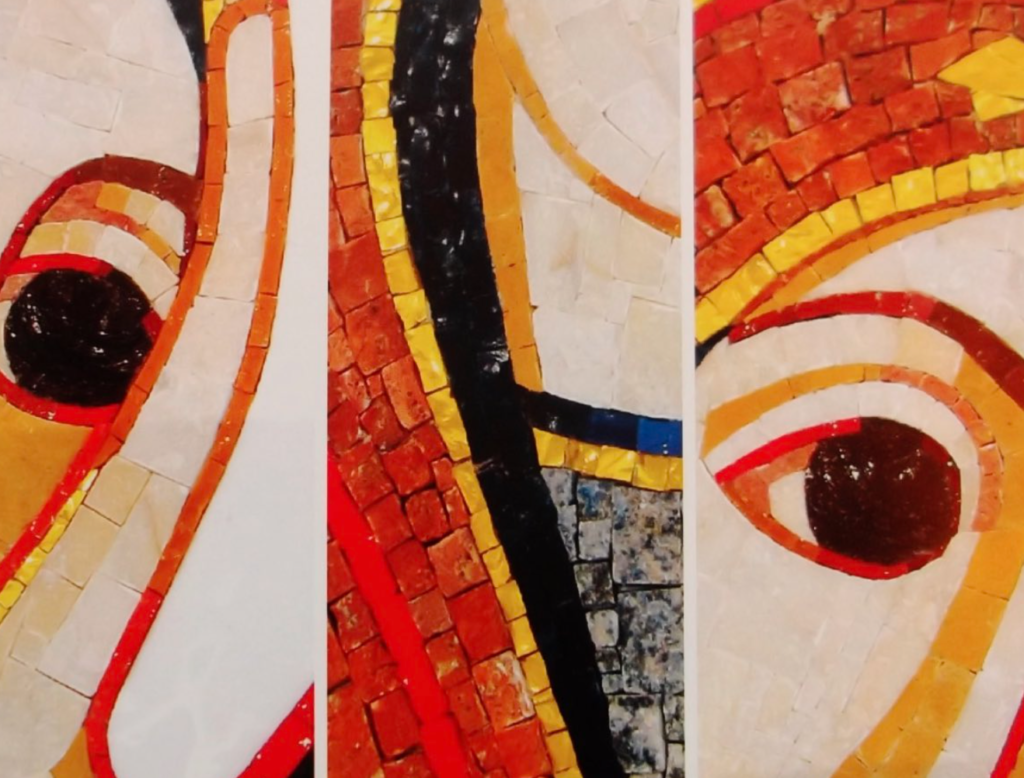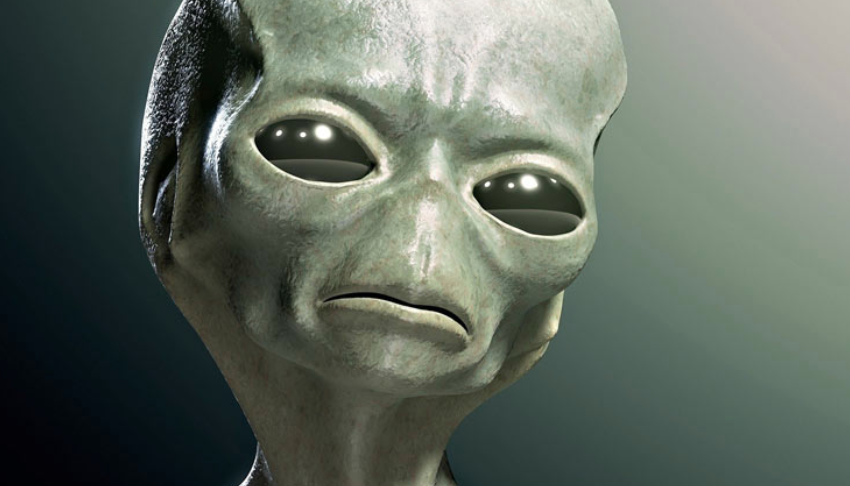The Abyssal Eyes Of Father Rupnik

Those are the eyes of the mosaics of the Jesuit priest Marko Ivan Rupnik, who stands credibly accused of widespread sexual assault of women religious. My TAC podcast partner Kale Zelden, a fed-up Catholic, says
Know what it reminds me of?

This creep Rupnik is a huge deal in Catholic church art. For example, his weird work defaces the cave of St. Ignatius of Loyola, founder of the Jesuit order. Excerpt:
Marko Rupnik explained that the mosaic is an extraordinary art that implies a communal experience. "A church experience, as a communion of people, which expresses who we are." The materials he uses come from all over the world and the artist assures that, in this technique, a dialogue is established with the stone. "The first lesson to cut the stone is to take it with love, with tenderness".
To be able to carry out this work right in the place where St. Ignatius of Loyola began to write the book of the Exercises, represents, for this Jesuit artist, a gift that he receives with "immense gratitude" and also as "a culmination of what throughout my life I have thought and studied".
In Catholic World Report, Christopher Altieri writes:
Every time we learn something new about the case, the mishandling of it at every level appears more appalling. There was the fine distinction between “covering up” and merely not saying anything, which Fr. Arturo Sosa – Superior General of the Society of Jesus – offered in the wake of the story’s breaking. There was the egregiously thin timeline the Jesuits published along with improbable assurances that victim “will be listened to with understanding and with empathy.”
The Jesuits’ response to this unutterably awful business has been ghastly, vile, horrid.
To hear one accuser tell it, the Jesuits knew about him in the ‘90s: Fr. Francisco Egaña SJ heard of Fr. Rupnik’s behavior no later than 1998; so did Tomáš Josef Špidlík, SJ – a close friend to Rupnik and a board member of the Centro Aletti art center of which Rupnik was the founding director – created Cardinal in 2003. All this puts the Dec. 14th statement from Fr. General Sosa in glaring light.
“The case of Fr. Marko Rupnik, which became public last week [i.e. the first week of December, Ed.],” said Fr. Sosa, “is a good example of how much we still have to learn, especially about people’s suffering.”
A candid observer may reasonably conclude that Churchmen – including, senior Jesuits, and including among those the one in the Apostolic Palace – are still trying to perfect the playbook they have employed in cases from Maciel, to McCarrick, to Danneels (who begged a child abused by his uncle – a priest – not to go to the police, after which Pope Francis appointed His Eminence to the Synod on the Family) and Delft (the Caritas director who had his way with boys on at least two continents) and Leatherby (whose grooming and abuse playbook tracks eerily with that of Rupnik) and … for God’s sake, how many others?
In 2018, Pope Francis said that he was “part of the problem” plaguing the Church. One is tempted to say, sic et simpliciter, that today Francis is the problem. Nevertheless, it is not just Francis. It is not only Francis with all his coterie of implausible goons. Leadership culture in the Church has been rotten for a very long time. Now, it appears that corruption permeates the Church’s whole leadership apparatus.
They all knew about this dirtbag. They all knew. But he was too important to touch. For some reason, his space-alien saints were too valuable to the Jesuit order and the Slovenian bishops to hold him to account -- certainly more important than the lives and souls of those poor women that Father Rupnik allegedly molested and violated for years.
At some point, Catholics are going to have to learn that the leadership class of their church cannot be trusted. They need to go to the police, first, and then, without fail, to the media. I forget who said it, but a good definition of a corrupt institution is one whose leaders know it's corrupt, but cannot or will not bring themselves to do anything about it.
I had dinner one night this week with a friend who is a fallen-away Catholic. I keep trying to think of ways I can encourage him to return to the practice of his faith, but I finally got from him a big reason why he won't: he is friends with a journalist who did a lot of investigation into the culture of sexual corruption in the Vatican. The journalist, who is a personal friend of my dinner companion, convinced him that the edifice of the pinnacle of the institutional church is rotten to the core. This good man, raised a Catholic, and now a father of small children, keeps his distance. What could I say to him? I lost my Catholic faith for pretty much the same reason.
I don't understand this. After over two decades of thinking about it, I am not much closer to understanding it than I ever was. I understand that men (and women) are sinful creatures. I don't expect any church to be perfect. I even understand and accept that God works through flawed men and women -- like you and me. But this I do not understand. I do not comprehend how men who have given their lives in the vowed service of God and His people can live with themselves knowing that they could have stopped people like Father Rupnik, but did not. The only answers I can come up with is that they don't see the laity as real, but rather as props for the real church, which is the clergy. That, and something a good priest in New York told me once: "They don't believe in God."
Bad men can produce great sacred art. I wrote yesterday about the regular visits I make, every time I'm in Rome, to Caravaggio's "The Calling Of St. Matthew," which hangs in a side chapel in the church of St. Louis King of France. Caravaggio was a lustful, violent man, but he could paint like an angel, and God is glorified through his paintings. Maybe even souls known only to God were called to conversion through contemplating Caravaggio's sacred artworks.
Subscribe Today
Get daily emails in your inbox
But Father Rupnik, the Caravaggio of Vogsphere, the homeworld of the Vogons and their inimitable poetry? For those abyssal eyes and cartoonish mosaics, the Jesuits and the bishops allowed Rupnik to get away with ravaging women under his spiritual care? I mean, look, not even Caravaggio would have been worth tolerating such evil ... but for Rupnik?
UPDATE:
We'd been to the Jesus People USA evangelical commune in Chicago, which had published highly negative critiques of Chick's series of lurid full size color comic book Roman Catholic "exposes". He had his large size india ink sheets of yet unpublished art in his "War Room." His source was the former Jesuit Alberto Romero, whose sensationalistic reports of what he said he witnessed seemed dubious because of the depth of the depravity conveyed. I mean, the image of the priest was that of those portrayed by genial actors like Bing Crosby and Pat O'Brien. Something had to be wrong. Yes, to the conservative Protestant, Roman Catholic theology was innovative beyond scripture and could credibly be termed heretical in some of those additions. And there were the well documented abuses that caused the Reformation long ago. But decadent and perverse sexual abuse rampant now? It seemed to cross the line into anti-Catholic bigotry that just had to be untrue.
But here we are and not only was it true, the reality makes Chick's take look like that of a naif.
Chick told me that he had been skeptical of the malfeasance he had had revealed at first, but told me he had been shown proof that was so terrible that he felt it would have violated his conscience not to give warning.
Now I'm convinced, long after Jack's passing.
Chick's arc regarding the Catholic church was that of a fundamentalist Baptist. He did not pay particular attention to Catholic theology until he was convinced by a Jesuit of the sexual abuse epidemic within the hierarchy. After that, he did link what he believed heresy to have allowed Satan entry.
Curiously this week it's reported that the Pope said demonic influence is walking the Vatican's corridors of power.
"Curiously this week it's reported that the Pope said demonic influence is walking the Vatican's corridors of power."
Well, he would know, wouldn't he?
The two points you come up with in your attempts to understand how such great evil can exist in the church and how individuals in the church can prove so dismissive of it both allude to spiritual pride. I think that is a key thing to focus on.
The Lord sent down an angel. It was enough to make me sob when the angel said, “The devil, and he's doing a damn good job."